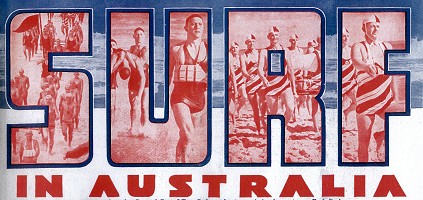 |
surfresearch.com.au
slsaa : surf in australia, 1940 |
| home | catalogue | history | references | appendix |
|

"Greenies" describes
the unbroken swells which are the delight of surf boat crews, surf-board
and surf-ski experts.
"Dumpers" are
the waves which rise quickly and fall heavily, oftentimes on a sandbank.
They are avoided
by the experienced surfer, who soon learns to distinguish the "dumpers"
from the "shoots" (waves which break evenly and carry him some distance).
"Howler" is a
synonym of "boomer."
The "front line"
has no war-like significance (unless the battle with the waves is taken
into account). It describes the position of those surfers who are farthest
out.
To "crack" a
wave means to swim onto it and then to ride it.
A "beacher" is
a wave which takes the surfer right to the shore.
To go "down the
mine" means to be hurled down to the bottom and there swirled about.
This usually
happens when one attempts to ride a "dumper" or an unmanageable wave.
"They're on" is
the cry which sets the heart of every keen surfer beating fast.
Someone has spied
a succession of big waves.
His ambition
is now to "crack" a "beacher."
"Out the back"
is the shout when someone sees an extra big wave rising from behind.
ORIGIN OF "CRAWL"
SWIMMING STROKE
(By courtesy
of Station 2CH)
My late grandfather
and granduncle, W. M. Wallis and J. H. Wallis, who were attending the Grammar
School, used to swim in these baths, after school hours, and, using the
breast stroke, they challenged an aboriginal boy to a race and were badly
beaten, as he used a strange over-arm stroke. The aboriginal boy (who was
encamped in the Domain bush with his father) taught these boys the new
stroke, and they gave him tobacco for his trouble.
The boys became
so proficient in this stroke, which they called the "overarm side stroke,"
that they could beat the aboriginal boy in a race.
In 1854 these
two boys were taken by their father, Mr. William Wallis, of Pott's Point,
to England, to complete their education.
While attending
St. John's College, Cambridge, they used to swim in the Greenwich Municipal
Baths. The proprietor of the baths, Mr. Beckwith, was so intrigued with
this new stroke that he learned it from the boys, and later taught his
swimming classes.
After returning
to Sydney in 1863, Mr. J. H. Wallis learned that Beckwith had claimed to
be the originator of this stroke.
He wrote to England
contradicting this, and after much controversy, and finally producing
declarations
from men who had witnessed the aboriginal boy's use of the stroke, he succeeded
in establishing his claim for the native boy.
For many years
we had an old album with the newspaper clippings from Sydney newspapers,
"The Referee" and "Evening News" or "Evening Star," written by J.H. Wallis,
of Enmore Sydney, giving the history of this interesting news.
Unfortunately,
this album has been destroyed by the bush-fire which burnt my home in January,
1939.
Mr. J. H. Wallis wrote on sporting matters under the pen-name of "Cantab."
As my late great-uncle, who introduced the stroke to England, was not known to the public at all, I thought it may be of interest for you to mention the public postion his father occupied in the colony at the time.
He, Mr. William
Wallis, was the first railway contractor in New South Wales, and built
the first section of the Sydney-Parramatta line, entering into the contract
on March 12th, 1851.
He only completed
the line from Ashfield to Haslem's Creek, for, owing to the rush
of men to the goldfields, it was so difficult to obtain workmen that he
was released from his contract and then retired from business and paid
a visit to England with his two sons to complete their education.
Fred Williams,
reputed to be the first Australian to perfect the art of body shooting,
died in Manly last month, mourned by all old surfing identities.
* * * *
Trophy From Honolulu
A trophy which
had been presented by Mr. G. Benny, of Honolulu, during the visit of the
S.L.S.A. team last year for surfboard race, and which was for perpetual
competition between teams from Australia and Honolulu, was delivered to
the Association by Mr. W. Hibberd, of the R.M.S. " Aorangi."
|
Surf in Australia. Official Organ of the Surf Life Saving Association of Australia (Head Centre), 119 Phillip, Street Sydney. Published by Alexander Leo Finn, 149 Dover Road, Rose Bay. Printed by Lake and Ashes Pty Ltd., 389-391 Sussex Street Sydney. 1940. |
 |

| home | catalogue | history | references | appendix |